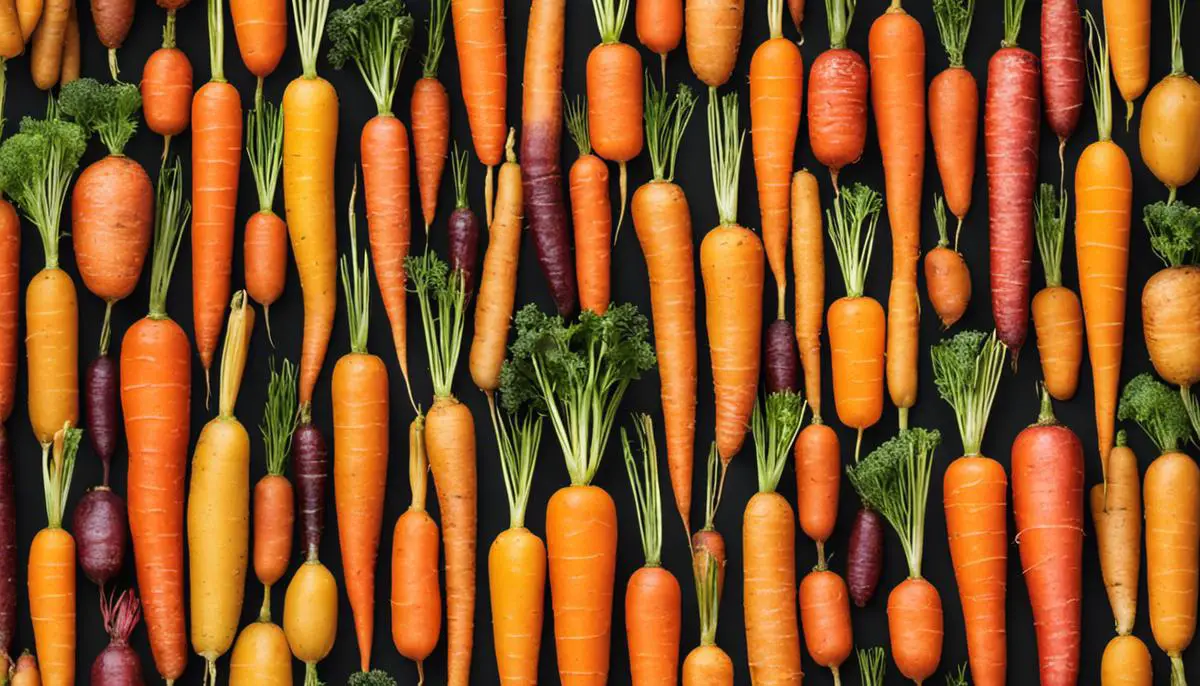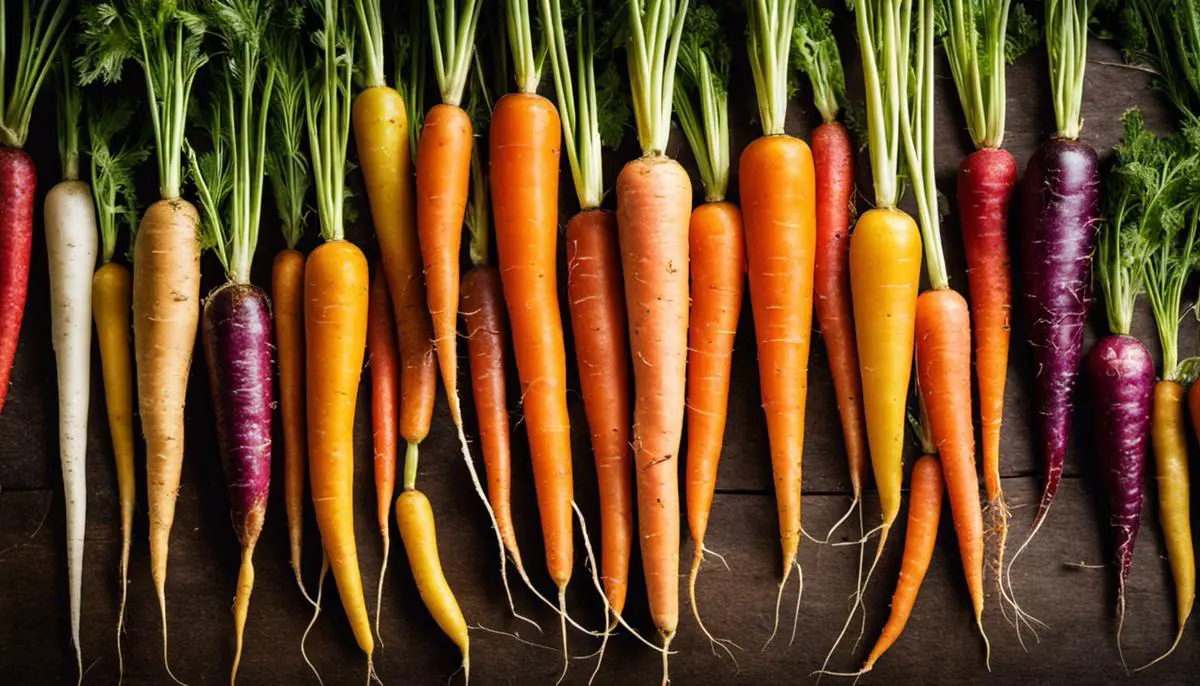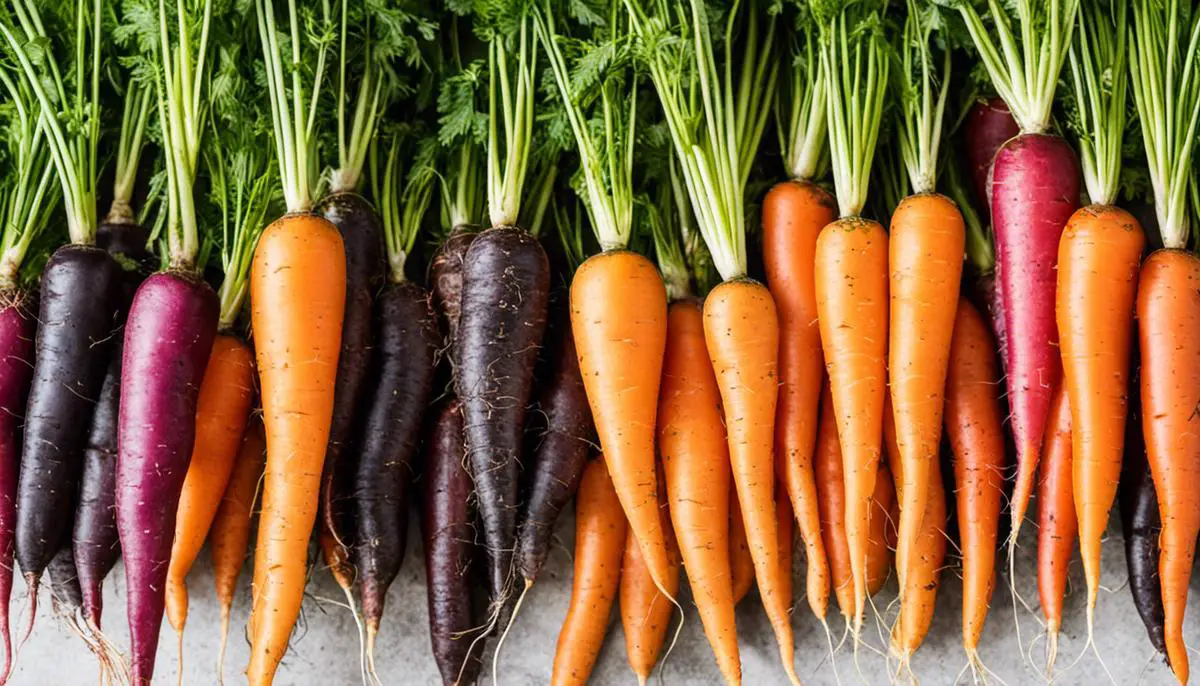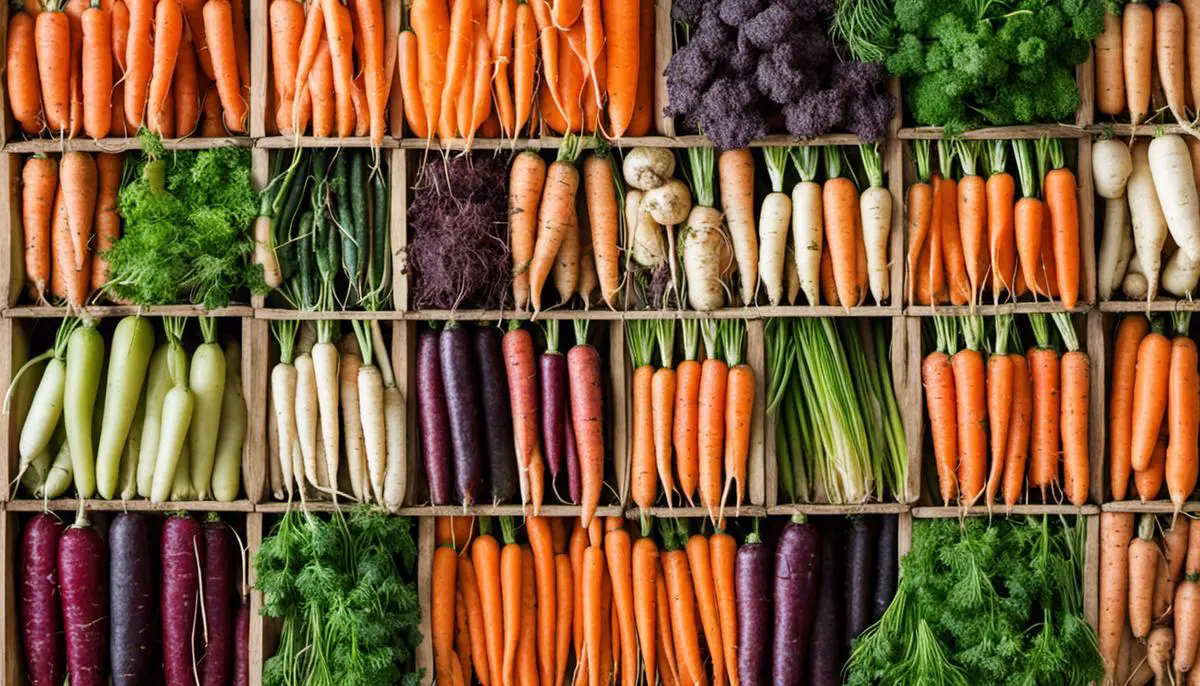Welcome to the fascinating world of carrots, a staple on dinner tables and a linchpin in countless recipes the world over. These vibrant veggies, with their spectrum of colors, sizes, and flavors, are as diverse as they come. Our journey begins with uncovering the captivating varieties of this universally loved root vegetable, plunging into their rich history, and unlocking the secrets behind their successful cultivation. We’ll delve into everything from the classic Nantes to the exotic Solar Yellow, understanding their unique characteristics and uses. Finally, we will explore the role carrots play in the culinary world, where each variety brings its own charm and distinctive flavors.
Understanding Carrot Varieties
A Rainbow Harvest: Unveiling the Different Varieties of Carrots
First things first, let’s give a hearty salute to the humble carrot! Despite its unassuming appearance, this colorful vegetable has managed to root itself deeply into the hearts of hobbyist gardeners and kitchen culinarians alike. Gracefully straddling the line between raw crunchiness and stewed sweetness, a carrot is a versatile marvel of the vegetable world. But today, we will dive deeper and explore the fascinating varieties of carrots that add flavor, color, and excitement to the art of gardening and culinary crafting.
Reader Poll: What online courses would interest you?
-
Nantes Carrots
First on the roster is the Nantes type, named after the city in France. It’s a popular garden variety because it’s extremely sweet, almost candy-like. Their even cylindrical shape and uniformly rounded ends are quite charming. They typically reach about six to seven inches in length – an ideal size for snacking or dicing into salads and stir-fries.
-
Danvers Carrots
Next up, meet the heirloom classic – the Danvers carrot. These carrots are longer and more tapered compared to Nantes, making them perfect for the main ingredient in heartwarming soups and stews. Their deep orange color means they’re rich in beta-carotene, a nutrient great for eye health. Gardeners love these because they tolerate heavier soils and are notably resilient.
-
Imperator Carrots
Imperator carrots are the long, slender beauties frequently seen gracing the shelves of grocery stores. Their vigorous growth and sweet, crisp flavor make them a top pick among commercial growers. However, keep in mind these might not be the best pick for compact, rocky soils due to their longer length.
-
Chantenay Carrots
Chantenay carrots are the epitome of compact and convenient. These short, cone-shaped root veggies are wider at the top and taper towards the end. These carrots are robust and can grow in most types of soil, even heavy clay. Their strong, earthy flavor makes them perfect for roasting and juicing.
-
Miniature/Baby Carrots
Contrary to popular belief, baby carrots aren’t just immature carrots harvested prematurely. Varieties like ‘Thumbelina’ and ‘Paris Market’ are genetically small yet come packed with flavor. Ideal for container gardens, these miniature wonders add a sweet, crunchy punch to meals and snacks alike.
-
Purple Carrots
Just when you thought the spectrum ended at orange, take a step into the world of purple and rainbow carrots. These varieties, such as ‘Purple Dragon’ or ‘Rainbow Blend’, offer a vibrant splash of color to your garden and plate. Their color indicates a high level of anthocyanins, potent antioxidants credited with numerous health benefits.
It’s fascinating how much variety, flavor, and color exist within a single classification of vegetable! Each variety of carrot carries its own unique charm and characteristic, allowing hobbyists to experiment, engage, and enjoy the vivid world of carrots. So, buckle up and let your exploration of these root vegetables be as colorful, varied, and exciting as the carrots themselves!

Digging into History: Carrots through the Ages
The Fascinating Origins of the Lesser-Known Carrot Varieties
It’s a joy to pull back the soil’s blanket and reveal a world resplendent with hues of orange, red, and yellow – the carrot harvest. Each variety, from the crunchy and sweet Nantes to the mellow-tasting Chantenay, has a remarkable history rooted in its DNA. But, what about the lesser-known carrot varieties that are equally intriguing on their own? Let’s delve into the fascinating world of heirloom and exotic carrot varieties that are a gem in the culinary world.
Yellow Carrots
To begin, let’s shed light on yellow carrots, known scientifically as Daucus carota var. sativus. Despite their less familiar hue, they actually closer to the original wild carrots than our conventional orange versions! Hailing from the Middle East and Central Asia, these golden treasures have been cultivated going back to the 900s. Packed with lutein, yellow carrots directly boost eye health and provide their unique buttery flavor when cooked.
Subscribe to our newsletter!
Red Carrots
Next on the palette of vivid carrot varieties are red carrots, somewhat of a rarity outside the Middle East and Asia, where they originated. These striking carrots owe their color to lycopene, the same antioxidant pigment found in tomatoes and watermelons. Offering an earthier taste, red carrots are popular in juices and stews, adding both flavor and color to any dish.
White Carrots
White carrots, an heirloom variety originally from Europe and Western Asia, are the least sweet among all the carrot types. They are typically used in soups and stews due to their robust body and ability to absorb surrounding flavors. White carrots also contain high amounts of fiber, a boon for gut health.
Black and Rainbow Carrots
When it comes to dramatic images, black carrots surely take center stage. These were first cultivated in the Middle East and became popular in Asia for their potent nutritional profile. They contain anthocyanins, one of the most powerful antioxidants known, providing potential anti-inflammatory and immune-boosting benefits. Raw or roasted, black carrots provide a sweet, earthy flavor.
Last but not least, the rainbow carrots, a true showstopper in the carrot world. These are not a single variety but a blend of carrots of different hues – from red and purple to white and yellow, collected to provide a visual treat.
Through years of evolution and cultivation, each carrot variety has written its own history and offers unique nutritional benefits and flavors. Understanding their origins can add a touch of wonder to your next culinary adventure and deepen your connection with this vibrant root vegetable. So, the next time you’re at the farmers’ market or choosing carrot seeds, don’t play it safe with the familiar orange types. Reach out for these remarkably diverse hues and rekindle a more vibrant connection with the history and magic of carrots.

Cultivation and Care of Different Carrot Types
Let’s delve further into the appealing world of cultivating diverse carrot types. On our invigorating journey, we unravel the different cultivation techniques and care methods attributed to the Firecracker, Lunar White, and Thumbelina carrots, all of which boast unique aesthetics and flavor profiles and can add a distinctive twist to home gardening.
Let’s start with Firecracker carrots, which steal attention with their name and hues! With a rainbow mix of purple, red, and yellow that thrust forward prominence and dietary value, they are a delightful sight in garden beds and salads. These carrots relish cooler temperatures, and for optimal growth, they are ideally planted in early spring or late summer. While they are hardy and somewhat forgiving, concentrating on soil composition can garner superb results. Always ensure it’s well-drained, as soggy ground could cause root decay.
Next up is the Lunar White carrot, which is as distinct as its name. The white exterior of this carrot variety is an unusual eye-catcher, and this pale wonder has a mild, subtly sweet flavor. This carrot prefers cool temperatures and will thrive in a roomy garden bed as it can grow up to 10 inches long. Make sure to pick a spot that receives enough sunshine – it requires a good six hours daily. Keep the soil moist but not waterlogged, and in deeper, loamy soil types, expect beautiful, straight roots without deformations.
Finally, let’s discuss cultivating a delightful miniatures variety: Thumbelina carrots. These are spherical in shape, as opposed to the familiar tapered format, akin to large radishes. They are quite sweet and bite-sized, making them popular with kids. These carrots are ideal for growing in containers or small-space gardening. Since they naturally grow compactly, they won’t hinder each other’s growth. Regular watering is the secret to keeping them happy; if the soil dries out, their sweet flavor can be masked by an unpleasantly sharp undertone.
While equally alluring, these selected varieties of carrots have different care requirements. Therefore, acknowledging and adjusting to these needs contributes significantly to a successful carrot harvest. For instance, Firecracker carrots demand well-drained soil, Lunar Whites love a lot of sunlight and spacious beds, and Thumbelinas thrive best in containers while needing regular watering. Being aware of such unique features and care protocols facilitates bountiful yields and happy gardening. And remember, irrespective of the variety, the secret to growing great carrots is keeping the soil consistently moist and providing plenty of sunlight.
So, why wait? Venture into exciting gardening endeavors, experimenting with diverse varieties of carrots that offer not only a feast for the eyes, but also a gourmet delight for the taste buds!

Cooking with Carrots: Varieties and their Uses in the Kitchen
Stepping onto the palate-awakening realm of Parisienne Carrots, a lesser-known variety, this type has a round, almost potato-like shape. Unlike elongated relatives, these tidy morsels are perfect for container gardening and have a sweet spot on the plate of French cuisine – notably in pot roasts where their size allows them to cook evenly.
Solar Yellow Carrots hanging on to the lineage of yellow ones, flaunt a vibrant sunny shade and a subtly sweet flavor. The warmer hue comes from their higher levels of xanthophyll — a nutrient known to promote good eye health. Commonly seen livening up stir-fry or contrasting in salads, their use is as refreshing as its appearance.
Delving deep into the ground, we find there’s more than color diversity when it comes to carrots. Among these are the Belgian Carrots, which cultivated commercially, grow to be massive in size. Known for their distinct earthy and slightly sweet flavor, they are typically included in hearty meals and stews, making them staple food in several European countries.
Atomic Red Carrots, carrying a red-tinged demeanor, are infused with an intense sweet flavor and pack a punch of lycopene – a substance known for boosting heart health. These gems stand out in salads, or when cooked in a medley of roasted vegetables, their spicy kick adding a twist to the culinary concoction.
And while we’re at it, let’s hone into the intriguing tale of Cosmic Purple Carrots. Beaming with a vibrant purple exterior and an orange core, these space-inspired carrots present a sweeter flavor than traditional orange ones. The versatile nature of these color-bursts makes them a star player on the roasting tray or a showoff in coleslaws.
In a nutshell, exploring these carrot variants not only escalates the home gardening experience but also brings a rainbow of nutritional benefits. Understanding the distinctiveness of each variety expands culinary horizons, inspiring creative and healthy dining options that are as pleasing to the eye as they are to the palate. Reach out and reap the diverse, vibrant roots of the carrot family. Learn to optimize their individual characteristics in their rightful culinary domain and relish the flavors they bring to the table. Happy gardening and tastier meals are just a carrot-pull away!

Carrots are not merely part of our diet, they tell stories of our historical past, reflect diversity, and add excitement to our cooking endeavors. They serve as a testament to human innovation and cultivation skill. Each type not just reflecting its unique properties, but also allowing us to appreciate the variety and complexity of Mother Nature’s food palette. They provide a world of choices for the home cook, from the crunchiness of the Nantes in salads to the stunning Purple Haze as the hero of roasted dishes. This exploration into the world of carrots is a reminder to appreciate the remarkable diversity in our vibrant world of fruits and vegetables.

